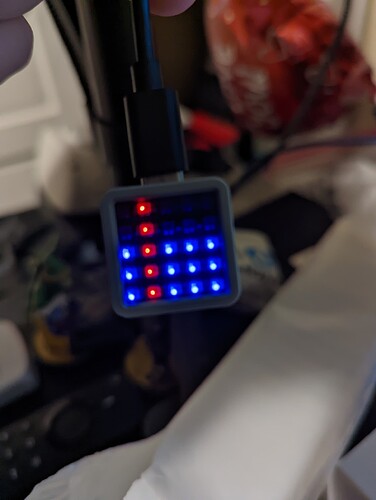I’m not always the best at remembering to brush my teeth before bed. To counter this forgetfulness, I had an NFC tag I used to tap when I did that, or else home assistant would remind me verbally (though a google speaker) to brush my teeth when I lay down in bed and turned the lights off. (Not going into the complexities of that today).
My toothbrush has a built in timer that makes sure you brush long enough, but I usually have google set a timer for when I’m using the mouthwash. This is awkward since the speaker is not in the bathroom, there is no way to see how much time is remaining (and you can’t ask with a mouth full of mouthwash).
So, I decided to consolidate a few things together, give myself a little project, and learn esphome while I was at it.
Originally, I was going to grab a smart button and an addressable light strip, then somehow convince my wife to let me add a light channel around the vanity (because wife approval factor is key), and have it do a clock countdown thing in a circle. I still think that would be cool, but that quickly became outside of my barely-there DIY skills. So, when I realized I already has something that could do both jobs at once in a form factor I didn’t hate, I switched tactics.
I’m not really much for hardware, so while I’m sure this would be easy to build, I chose to use an M5 Atom Matrix since it basically had everything in a tiny footprint that I wanted to do (and I happened to have one laying around, but they are like $15 after shipping, which is awesome). Here are the technical specs for it.
Now, what I wanted was to have a button I could hit that would count down visually when I pressed the button, and was readable ‘at a glance’. I went through a few iterations of how I was going to do this 60-second countdown on a 5x5 pixel grid. What I eventually landed on was to have it draw a 5 pixel wide by x-height tall bar to represent blocks of 10 seconds, and have a vertical 1-pixel wide by 5 pixel tall bar scroll across the screen as a sort of every-other-second counter, so I could quickly see how much time was left. It ends up looking like so while it is counting down:
(basically this would be either 33 or 34 seconds remaining)
When the counter hits 0, the device goes dark, since I don’t want light leaking from the bathroom into my bedroom when I’m trying to sleep. I also added a trigger in home assistant so that triggering this countdown flips my teeth brushed boolean, so I don’t need to bring my phone with me to brush my teeth any more, which is also nice.
Anyway, here is the code I used for this:
esphome:
name: countdown-timer
esp32:
board: m5stack-atom
framework:
type: arduino
# Enable logging
logger:
# Enable Home Assistant API
api:
ota:
password: !secret wifi_password
wifi:
ssid: !secret wifi_ssid
password: !secret wifi_password
# Enable fallback hotspot (captive portal) in case wifi connection fails
ap:
ssid: "Countdown-Timer Fallback Hotspot"
password: !secret wifi_password
captive_portal:
sensor:
- platform: wifi_signal
id: wifi_value
name: "WiFi Signal Sensor"
- platform: template
name: "Countdown Timer"
unit_of_measurement: "seconds"
icon: "mdi:timer"
update_interval: 1s
state_class: "measurement"
accuracy_decimals: 0
lambda: |-
return id(countdown_timer).state;
number:
- platform: template
id: countdown_timer
optimistic: true
min_value: 0
max_value: 60
initial_value: 0
step: 1
on_value:
- if:
condition:
number.in_range:
id: countdown_timer
below: 9
then:
- number.set:
id: bar_height
value: 5
- if:
condition:
number.in_range:
id: countdown_timer
above: 10
below: 19
then:
- number.set:
id: bar_height
value: 4
- if:
condition:
number.in_range:
id: countdown_timer
above: 20
below: 29
then:
- number.set:
id: bar_height
value: 3
- if:
condition:
number.in_range:
id: countdown_timer
above: 30
below: 39
then:
- number.set:
id: bar_height
value: 2
- if:
condition:
number.in_range:
id: countdown_timer
above: 40
below: 49
then:
- number.set:
id: bar_height
value: 1
- if:
condition:
number.in_range:
id: countdown_timer
above: 50
then:
- number.set:
id: bar_height
value: 0
- if:
condition:
lambda: |-
//Check if countdown timer is currently even
int countdown = id(countdown_timer).state;
return countdown % 2 == 0;
then:
- number.set:
id: ticker
value: !lambda |-
// Return the current ticker value plus 1
return id(ticker).state + 1;
- platform: template
id: bar_height
optimistic: true
min_value: 0
max_value: 5
initial_value: 5
step: 1
- platform: template
id: ticker
optimistic: true
min_value: 0
max_value: 5
initial_value: 5
step: 1
on_value:
- if:
condition:
- number.in_range:
id: ticker
above: 5
- number.in_range:
id: countdown_timer
above: 1
then:
- number.set:
id: ticker
value: 0
time:
- platform: homeassistant
id: homeassistant_time
on_time:
- seconds: '*'
then:
if:
condition:
number.in_range:
id: countdown_timer
above: 1
then:
- number.set:
id: countdown_timer
value: !lambda |-
// Return the current countdown value less 1
return id(countdown_timer).state - 1;
binary_sensor:
- platform: gpio # btn
name: "Timer Button"
id: button1
pin:
number: 39
inverted: true
on_press:
- logger.log: "Timer started"
- number.set:
id: countdown_timer
value: 60
- number.set:
id: bar_height
value: 0
- number.set:
id: ticker
value: 0
light:
- platform: neopixelbus
type: GRB
variant: WS2812x
pin: 27
num_leds: 25
id: led_matrix_light
color_correct: [30%, 30%, 30%]
restore_mode: ALWAYS_OFF
display:
- platform: addressable_light
id: led_matrix_display
addressable_light_id: led_matrix_light
width: 5
height: 5
rotation: 180
update_interval: 16ms
lambda: |-
// Count Down from 60
Color red = Color(0xFF0000);
Color green = Color(0x00FF00);
Color blue = Color(0x0000FF);
it.filled_rectangle(0, id(bar_height).state, 5, 5, blue);
it.vertical_line(id(ticker).state, 0, 5, red);
Anywho, that’s what I came up with. I’m pretty happy with it for a first project. I’ve never worked in C++ before, and I’ve definitely never mixed C++ and yaml before, so this was an interesting one for me.

